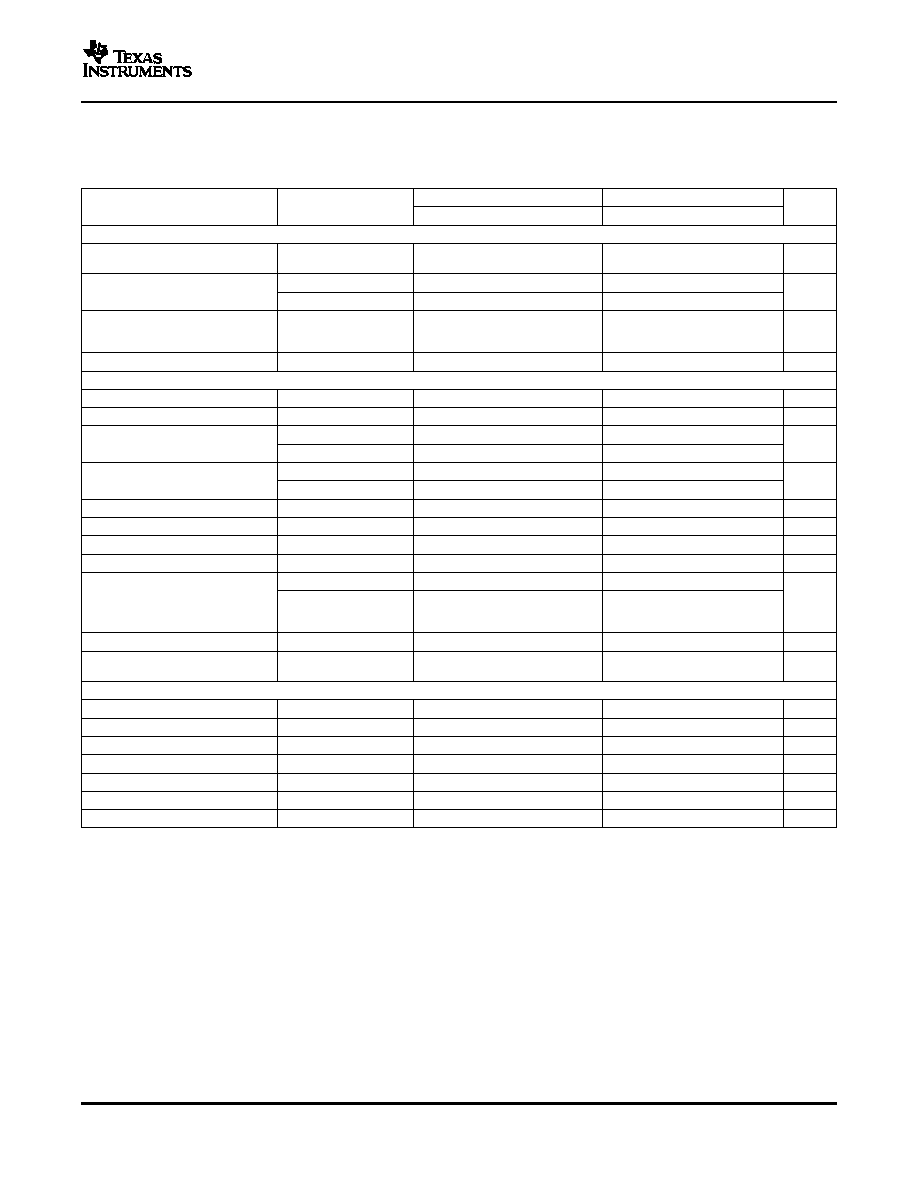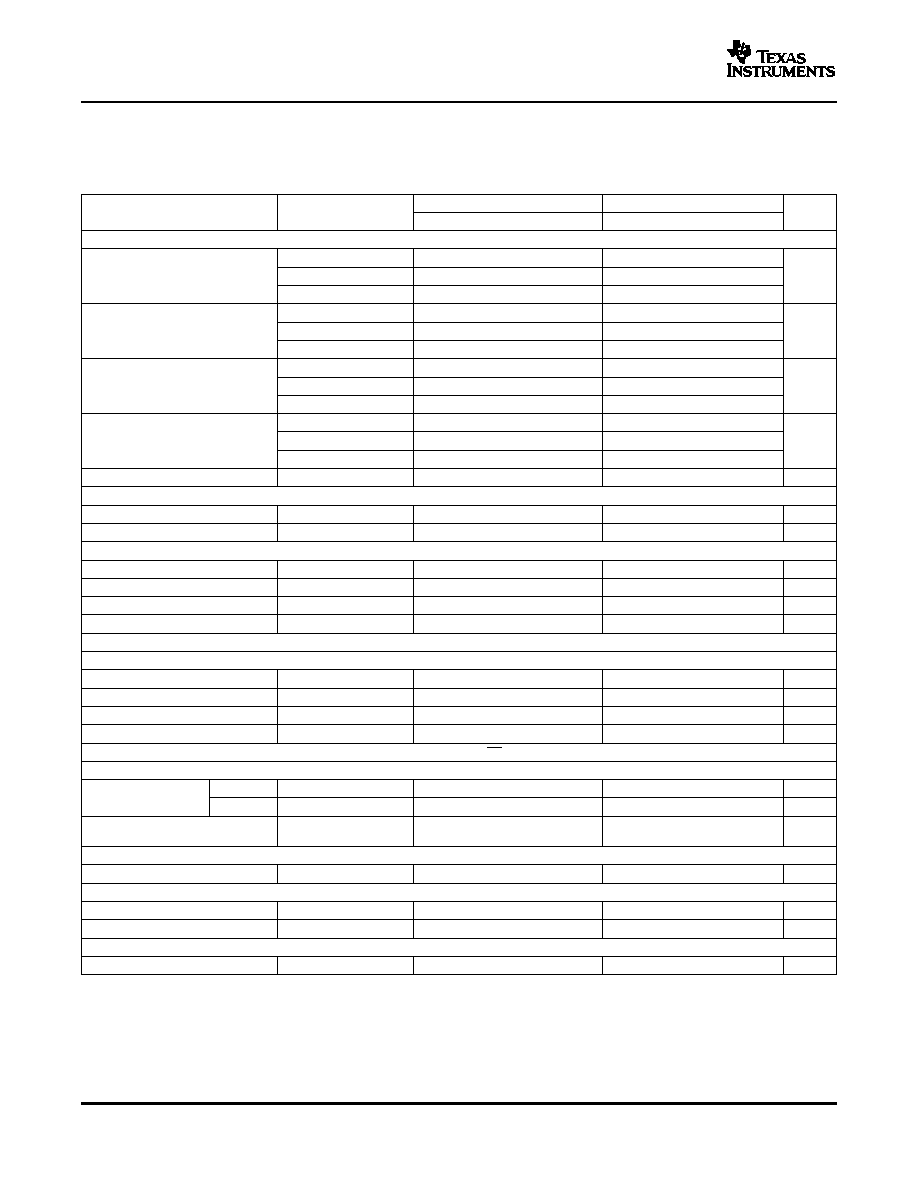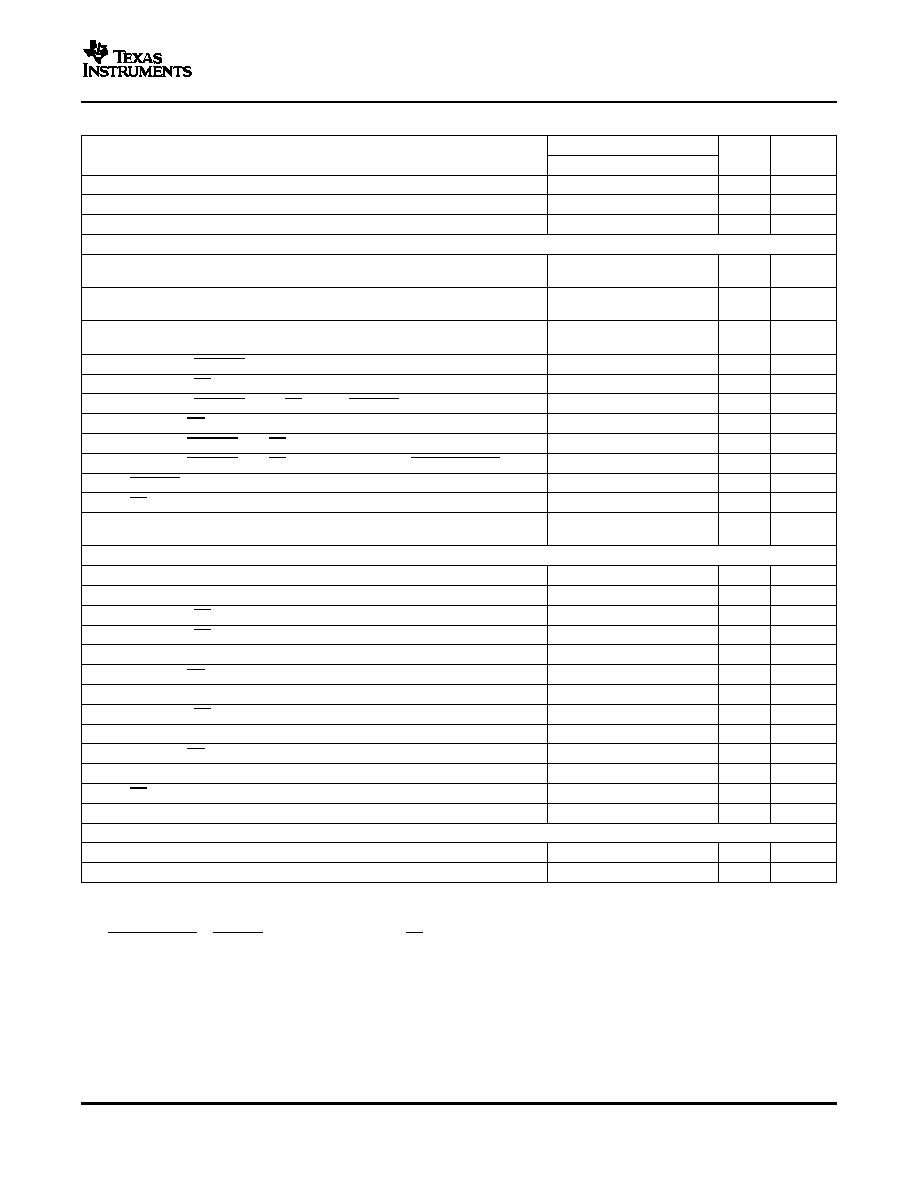 | ÐлекÑÑоннÑй компоненÑ: ADS8370IB | СкаÑаÑÑ:  PDF PDF  ZIP ZIP |
Äîêóìåíòàöèÿ è îïèñàíèÿ www.docs.chipfind.ru

Burr Brown Products
from Texas Instruments
FEATURES
APPLICATIONS
DESCRIPTION
CDAC
_
+
Output
Latches
and
3-State
Drivers
FS
SAR
Conversion
and
Control Logic
Comparator
Clock
+IN
-IN
REFIN
CONVST
BUSY
CS
PD
4.096-V
Internal
Reference
REFOUT
SCLK
SDO
SB/2C
ADS8370
SLAS450 JUNE 2005
16-BIT, 600-kHz, PSEUDO-DIFFERENTIAL INPUT, MICROPOWER SAMPLING
ANALOG-TO-DIGITAL CONVERTER WITH SERIAL INTERFACE AND REFERENCE
·
Pin compatible With 18-Bit ADS8380
·
600-kHz Sample Rate
·
±0.5 LSB Typ, ±1.25 LSB Max INL
·
Medical Instruments
·
±0.4 LSB Typ, ±0.75 LSB Max DNL
·
Optical Networking
·
16-Bit NMC
·
Transducer Interface
·
SINAD 89.5 dB, SFDR 119 dB at f
i
= 1 kHz
·
High Accuracy Data Acquisition Systems
·
High-Speed Serial Interface up to 40 MHz
·
Magnetometers
·
Onboard Reference Buffer
·
Onboard 4.096-V Reference
·
Pseudo-Differential Input, 0 V to 4.2 V
The ADS8370 is a high performance 16-bit, 600-kHz
·
Onboard Conversion Clock
A/D converter with single-ended (pseudo-differential)
·
Selectable Output Format, 2's Complement or
input. The device includes an 16-bit capacitor-based
Straight Binary
SAR A/D converter with inherent sample and hold.
The ADS8370 offers a high-speed CMOS serial
·
Zero Latency
interface with clock speeds up to 40 MHz.
·
Wide Digital Supply
·
Low Power:
The ADS8370 is available in a 28 lead 6 × 6 QFN
package and is characterized over the industrial
110 mW at 600 kHz
40°C to 85°C temperature range.
15 mW During Nap Mode
10
µ
W During Power Down
·
28-Pin 6 x 6 QFN Package
High Speed SAR Converter Family
Type/Speed
500 kHz
~ 600 kHz
750 kHZ
1 MHz
1.25 MHz
2 MHz
3 MHz
4 MHz
ADS8383
ADS8381
18-Bit Pseudo-Diff
ADS8380 (S)
18-Bit Pseudo-Bipolar, Fully Diff
ADS8382 (S)
16-Bit Pseudo-Diff
ADS8370 (S)
ADS8371
ADS8401/05
ADS8411
16-Bit Pseudo-Bipolar, Fully Diff
ADS8372 (S)
ADS8402/06
ADS8412
14-Bit Pseudo-Diff
ADS7890 (S)
ADS7891
12-Bit Pseudo-Diff
ADS7886
ADS7881
Please be aware that an important notice concerning availability, standard warranty, and use in critical applications of Texas
Instruments semiconductor products and disclaimers thereto appears at the end of this data sheet.
PRODUCTION DATA information is current as of publication date.
Copyright © 2005, Texas Instruments Incorporated
Products conform to specifications per the terms of the Texas
Instruments standard warranty. Production processing does not
necessarily include testing of all parameters.

www.ti.com
ABSOLUTE MAXIMUM RATINGS
ADS8370
SLAS450 JUNE 2005
These devices have limited built-in ESD protection. The leads should be shorted together or the device
placed in conductive foam during storage or handling to prevent electrostatic damage to the MOS gates.
ORDERING INFORMATION
(1)
MAXIMUM
MAXIMUM
NO MISSING
TRANSPORT
INTEGRAL
DIFFERENTIAL
CODES
PACKAGE
PACKAGE
TEMPERATURE
ORDERING
MODEL
MEDIA
LINEARITY
LINEARITY
RESOLUTION
TYPE
DESIGNATOR
RANGE
INFORMATION
QUANTITY
(LSB)
(LSB)
(BIT)
Small Tape and
ADS8370IRHPT
reel 250
28 Pin
ADS8370I
±2
1/1.5
16
RHP
40°C to 85°C
6×6 QFN
Tape and reel
ADS8370IRHPR
2500
Small Tape and
ADS8370IBRHPT
reel 250
28 Pin
ADS8370IB
±1.25
±0.75
16
RHP
40°C to 85°C
6×6 QFN
Tape and reel
ADS8370IBRHPR
2500
(1)
For the most current package and ordering information, see the Package Option Addendum at the end of this document, or see the TI
website at www.ti.com.
over operating free-air temperature range unless otherwise noted
(1)
UNIT
+IN to AGND
0.3 V to +VA + 0.3 V
IN to AGND
0.3 V to +VA + 0.3 V
Voltage
+VA to AGND
0.3 V to 6 V
+VBD to BDGND
0.3 V to 6 V
Digital input voltage to BDGND
0.3 V to +VBD + 0.3 V
Digital input voltage to +VA
+0.3 V
Operating free-air temperature range, T
A
40°C to 85°C
Storage temperature range, T
stg
65°C to 150°C
Junction temperature (T
J
max)
150°C
Power dissipation
(T
J
max T
A
)/
JA
QFN package
JA
thermal impedance
86°C/W
Vapor phase (60 sec)
215°C
Lead temperature, soldering
Infrared (15 sec)
220°C
(1)
Stresses beyond those listed under "absolute maximum ratings" may cause permanent damage to the device. These are stress ratings
only, and functional operation of the device at these or any other conditions beyond those indicated under "recommended operating
conditions" is not implied. Exposure to absolute-maximum-rated conditions for extended periods may affect device reliability.
2

www.ti.com
SPECIFICATIONS
ADS8370
SLAS450 JUNE 2005
At 40°C to 85°C, +VA = +5 V, +VBD = +5 V or +VBD = +2.7 V, using internal or external reference, f
SAMPLE
= 600 kHz,
unless otherwise noted. (All performance parameters are valid only after device has properly resumed from power down, see
Table 2
.)
ADS8370IB
ADS8370I
PARAMETER
TEST CONDITIONS
UNIT
MIN
TYP
MAX
MIN
TYP
MAX
ANALOG INPUT
Full-scale
+IN (IN)
0
V
ref
0
V
ref
V
input voltage
(1)
+IN
0.2
V
ref
+ 0.2
0.2
V
ref
+ 0.2
Absolute input voltage
V
IN
0.2
0.2
0.2
0.2
Sampling capacitance
(measured from ±IN to
40
40
pF
AGND)
Input leakage current
1
1
nA
SYSTEM PERFORMANCE
Resolution
16
16
Bits
No missing codes
16
16
Bits
Quiet zones observed
1.25
±0.5
1.25
2
2
LSB
INL
Integral linearity
(2) (3) (4)
(16 bit)
Quiet zones not observed
±0.8
Quiet zones observed
0.75
±0.4
0.75
1
1.5
LSB
DNL
Differential linearity
(3)
(16 bit)
Quiet zones not observed
±0.75
E
O
Offset error
(3)
0.75
±0.4
0.75
1.5
1.5
mV
Offset temperature drift
(3)
±0.4
±0.4
ppm/°C
E
G
Gain error
(3) (5)
0.075
0.075
0.15
0.15
%FS
Gain temperature drift
(3) (5)
±1.25
±1.25
ppm/°C
At DC
80
80
[+IN (IN)] = V
ref
/2 with
CMRR
Common-mode rejection ratio
dB
50 mV
p-p
common mode
55
55
signal at 1 MHz
Noise
At 0 V analog input
40
40
µ
V RMS
DC Power supply rejection
PSRR
At full scale analog input
55
55
dB
ratio
SAMPLING DYNAMICS
Conversion time
1.0
1.16
1.0
1.16
µ
s
Acquisition time
0.50
0.50
µ
s
Throughput rate
600
600
kHz
Aperture delay
10
10
ns
Aperture jitter
12
12
ps RMS
Step response
(6)
400
400
ns
Overvoltage recovery
400
400
ns
(1)
Ideal input span; does not include gain or offset error.
(2)
LSB means least significant bit.
(3)
Measured using analog input circuit in
Figure 51
and digital stimulus in
Figure 56
and
Figure 57
and reference voltage of 4.096 V.
(4)
This is endpoint INL, not best fit.
(5)
Measured using external reference source so does not include internal reference voltage error or drift.
(6)
Defined as sampling time necessary to settle an initial error of Vref on the sampling capacitor to a final error of 1 LSB at 16-bit level.
Measured using the input circuit in
Figure 51
.
3

www.ti.com
ADS8370
SLAS450 JUNE 2005
SPECIFICATIONS (continued)
At 40°C to 85°C, +VA = +5 V, +VBD = +5 V or +VBD = +2.7 V, using internal or external reference, f
SAMPLE
= 600 kHz,
unless otherwise noted. (All performance parameters are valid only after device has properly resumed from power down, see
Table 2
.)
ADS8370IB
ADS8370I
PARAMETER
TEST CONDITIONS
UNIT
MIN
TYP
MAX
MIN
TYP
MAX
DYNAMIC CHARACTERISTICS
VIN = 4 V
p-p
at 1 kHz
112
111
Total harmonic
THD
VIN = 4 V
p-p
at 10 kHz
111
111
dB
distortion
(7) (8)
VIN = 4 V
p-p
at 100 kHz
92
92
VIN = 4 V
p-p
at 1 kHz
89.5
89.5
SNR
Signal-to-noise ratio
(7)
VIN = 4 V
p-p
at 10 kHz
89.5
89
dB
VIN = 4 V
p-p
at 100 kHz
89.5
88.5
VIN = 4 V
p-p
at 1 kHz
89.5
89.5
Signal-to-noise
SINAD
VIN = 4 V
p-p
at 10 kHz
89.5
89
dB
+ distortion
(7) (8)
VIN = 4 V
p-p
at 100 kHz
87.5
87
VIN = 4 V
p-p
at 1 kHz
119
119
Spurious free dynamic
SFDR
VIN = 4 V
p-p
at 10 kHz
117
117
dB
range
(7)
VIN = 4 V
p-p
at 100 kHz
92
92
3dB Small signal bandwidth
75
75
MHz
REFERENCE INPUT
V
ref
Reference voltage input range
2.5
4.096
4.2
2.5
4.096
4.2
V
Resistance
(9)
10
10
M
INTERNAL REFERENCE OUTPUT
V
ref
Reference voltage range
IOUT = 0 A, T
A
= 30°C
4.088
4.096
4.104
4.088
4.096
4.104
V
Source current
Static load
10
10
µ
A
Line regulation
+VA = 4.75 V to 5.25 V
2.5
2.5
mV
Drift
IOUT = 0 A
25
25
ppm/°C
DIGITAL INPUT/OUTPUT
Logic family CMOS
V
IH
High level input voltage
+VBD 1
+VBD + 0.3
+VBD 1
+VBD + 0.3
V
V
IL
Low level input voltage
0.3
0.8
0.3
0.8
V
V
OH
High level output voltage
I
OH
= 2 TTL loads
+VBD 0.6
+VBD 0.6
V
V
OL
Low level output voltage
I
OL
= 2 TTL loads
0.4
0.4
V
Data format: MSB first, 2's complement or straight binary (selectable via the SB/2C pin)
POWER SUPPLY REQUIREMENTS
+VA
4.75
5
5.25
4.75
5
5.25
V
Power supply
voltage
+VBD
2.7
3.3
5.25
2.7
3.3
5.25
V
Supply current, 600-kHz
I
CC
+VA = 5 V
22
25
22
25
mA
sample rate
(10)
POWER DOWN
I
CC(PD)
Supply current, power down
2
2
µ
A
NAP MODE
I
CC(NAP)
Supply current, nap mode
3
3
mA
Power-up time from nap
300
300
ns
TEMPERATURE RANGE
Specified performance
40
85
40
85
°C
(7)
Measured using analog input circuit in
Figure 51
and digital stimulus in
Figure 56
and
Figure 57
and reference voltage of 4.096 V.
(8)
Calculated on the first nine harmonics of the input frequency.
(9)
Can vary +/-30%.
(10) This includes only +VA current. With +VBD = 5 V, +VBD current is typically 1 mA with a 10-pF load capacitance on the digital output
pins.
4

www.ti.com
TIMING REQUIREMENTS
(1) (2) (3) (4) (5) (6)
ADS8370
SLAS450 JUNE 2005
ADS8370I/ADS8370IB
REF
PARAMETER
UNIT
FIGURE
MIN
TYP
MAX
t
conv
Conversion time
1000
1160
ns
41 44
t
acq1
Acquisition time in normal mode
0.5
µs
41,42,44
t
acq2
Acquisition time in nap mode (t
acq2
= t
acq1
+ t
d18
)
0.8
µs
43
CONVERSION AND SAMPLING
Quite sampling time (last toggle of interface signals to convert start
40 43,
t
quiet1
30
ns
command)
(6)
45 47
Quite sampling time (convert start command to first toggle of interface
40 43,
t
quiet2
10
ns
signals)
(6)
45 47
Quite conversion time (last toggle of interface signals to fall of BUSY)
(6)
40 43,
t
quiet3
600
ns
45,47
t
su1
Setup time, CONVST before BUSY fall
15
ns
41
t
su2
Setup time, CS before BUSY fall (only for conversion/sampling control)
20
ns
40,41
t
su4
Setup time, CONVST before CS rise (so CONVST can be recognized)
5
ns
41,43,44
t
h1
Hold time, CS after BUSY fall (only for conversion/sampling control)
0
ns
41
t
h3
Hold time, CONVST after CS rise
7
ns
43
t
h4
Hold time, CONVST after CS fall (to ensure width of CONVST_QUAL)
(4)
20
ns
42
t
w1
CONVST pulse duration
20
ns
43
t
w2
CS pulse duration
10
ns
41,42
Pulse duration, time between conversion start command and conversion
t
w5
1000
ns
44
abort command to successfully abort the ongoing conversion
DATA READ OPERATION
t
cyc
SCLK period
25
ns
45 47
SCLK duty cycle
40%
60%
t
su5
Setup time, CS fall before first SCLK fall
10
ns
45
t
su6
Setup time, CS fall before FS rise
7
ns
46,47
t
su7
Setup time, FS fall before first SCLK fall
7
ns
46,47
t
h5
Hold time, CS fall after SCLK fall
3
ns
45
t
h6
Hold time, FS fall after SCLK fall
7
ns
46,47
t
su2
Setup time, CS fall before BUSY fall (only for read control)
20
ns
40,45
t
su3
Setup time, FS fall before BUSY fall (only for read control)
20
ns
40,47
t
h2
Hold time, CS fall after BUSY fall (only for read control)
15
ns
40,45
t
h8
Hold time, FS fall after BUSY fall (only for read control)
15
ns
40,47
t
w2
CS pulse duration
10
ns
45
t
w3
FS pulse duration
10
ns
46,47
MISCELLANEOUS
t
w4
PD pulse duration for reset and power down
60
ns
53,54
All unspecified pulse durations
10
ns
(1)
All input signals are specified with t
r
= t
f
= 5 ns (10% to 90% of V
DD
) and timed from a voltage level of (V
IL
+ V
IH
)/2.
(2)
All specifications typical at 40°C to 85°C, +VA = +4.75 V to +5.25 V, +VBD = +2.7 V to +5.25 V.
(3)
All digital output signals loaded with 10-pF capacitors.
(4)
CONVST_QUAL is CONVST latched by a low value on CS (see
Figure 39
).
(5)
Reference figure indicated is only a representative of where the timing is applicable and is not exhaustive.
(6)
Quiet time zones are for meeting performance and not functionality.
5
Document Outline




